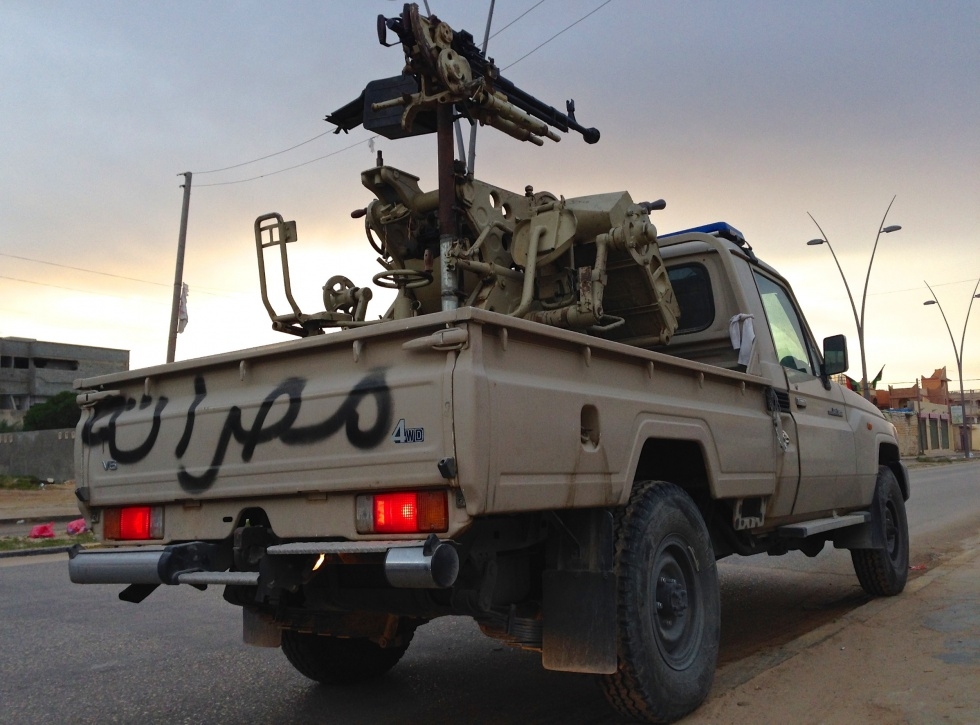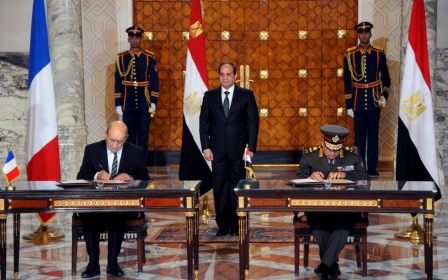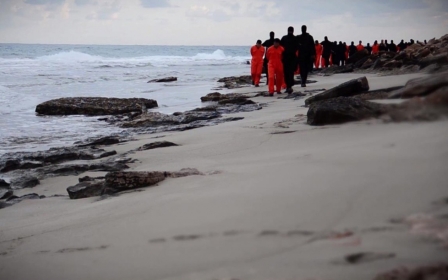Tripoli-allied troops begin Islamic State assault

TRIPOLI – The Tripoli-based government on Monday started deploying Libyan troops to wrest control of the town of Sirte from IS militants. The move came on the same day as Egypt launched airstrikes on Libya’s eastern town of Derna, following the killing of 21 of its nationals by Islamic State militants.
“We have about 100 vehicles stationed outside Sirte, from where we are monitoring the enemy, and another brigade is now being deployed,” said Sergeant Mohamed al-Turki from the Misrata military operations room.
The town and outlying areas were surrounded by some 2,800 military personnel from Libya’s third city of Misrata, he said.
“We are against Daesh (the Arabic acronym for IS), but we are giving them time. We want them to surrender to avoid civilian casualties but, if they do surrender, we won’t let them escape, they will be brought to justice.”
But while Tripoli and Egypt might now be facing off against the same enemy, tensions have intensified with the Tripoli-based government and its parliament the General National Congress (GNC), which have strongly condemned Egypt for its “attack on Libyan sovereignty” while also expressing solidarity with the airstrikes’ victims.
The escalation in fighting has also left Tripoli-led army units and armed groups (known as Libya Dawn) facing off on multiple fronts and, according to sources in both camps, will not help to heal divisions with the rival Tobruk-based parliament, the House of Representatives (HoR).
Senior members of the Libyan army, allied with the HoR, and its spokesman Mohamed Hijazi, have repeatedly referred to Libya Dawn as terrorists and supporters of terrorist groups, including Ansar al-Sharia.
Scale of IS threat
IS first established a foothold in Sirte, a coastal town best known for being the birthplace of former leader Muammar Gaddafi (ousted four years ago today), last year and it is widely believed that it was behind the December kidnappings of 21 Egyptian Copts.
Turki estimated that there are now some 400 IS members in Sirte and said he believes that they control the centre of the city, occupying government institutions and private companies, including a fortified underground chamber which, he said, was functioning as the group’s operations room.
According to Turki, IS has also deployed snipers on all the highest buildings across the town. This development was holding back the Joint Force - comprising military brigades sent from Misrata - from entering the town, he added, while explaining that targeting the snipers would cause severe damage.
However, once the attack was launched, he said, the town could be secured “within days”.
Field Commander Abu Bakr Meitig, serving as part of the Tripoli government’s Misrata-led Joint Force, described those occupying Sirte as an “IS project” which needed to be eliminated swiftly before it could increase in size, stressing that the current situation was not indicative of the spread of the Islamic State in Libya.
“IS is an international network but the people in Sirte aren’t actually IS, they are trying to be,” he said. “Some are members of Ansar al-Sharia (another militant group that until recently controlled much of the eastern city of Benghazi) who moved to IS and convinced others to join them.”
The release of a video by the IS al-Hayat media centre showing the execution of 21 Egyptians, reportedly on a beach just outside Sirte, however, suggests that the threat is being underplayed. Shot from several angles, the high-production values of the five-minute film are in keeping with previous IS videos.
IS has been steadily gaining a foothold along the oil-rich Gulf of Sirte and has repeatedly targeted the military operating under the Tripoli-based government. It also claimed responsibility for a deadly January attack on Tripoli’s Corinthia Hotel. Nine people, including five foreigners, were killed, with the Tripoli government claiming Prime Minister Omar al-Hassi was the intended target.
In the past two months, 15 soldiers loyal to Tripoli were kidnapped along the coastal highway. When IS took control of the town of Nufaliya - 130 kilometres east of Sirte - last week, the decapitated bodies of four of these soldiers were found by the roadside.
The militant group is also believed to be responsible for attacks on three oil fields in the area under control of the Tripoli government earlier this month. Ten people were killed in the attack on Mabruk oil field on 3 February and three Filipino workers seized.
“IS has become a third frontline for the [Tripoli-led] military,” a local official said. “It [Tripoli-led forces] are already fighting the other [Tobruk-based] government - both at the Es Sidra oil port and in the west of Libya - but [they] are now also being attacked by IS.”
So, while a Joint Force commander outside Sirte said that it already controls the Ibn Sina hospital, a steam power plant and an air base on the outskirts of the town, its gains are at risk.
Fighting on several fronts
The Libyan National Army (LNA), the military wing of Libya’s internationally recognised government now sitting in the eastern town of Beida, has kept up pressure on Tripoli despite the two sides both opposing IS. On Sunday, a day before the Egyptian strikes, the LNA bombed the currently disused Sirte airbase under control of the Joint Force, causing minor damage. It has been bombing sites in Sirte.
“If they can bomb us, why don’t they bomb Daesh?” another official at the Misrata military operations room said. “We need the international community to help stop these airstrikes.”
Controlling the - albeit limited - Libyan Air Force fleet, aerial bombardment remains the Beida government’s trump card over its Tripoli-based rivals, which admits to having no viable air power.
Its only course of action against IS is to employ ground forces with heavy weaponry, an approach that has so far proved slow-moving on other front lines in Libya’s chaotic civil war.
Echoing the political line in Tripoli, Colonel Salem Mohamed Ghasbi, commander of the Misrata military operations room, claimed IS in Sirte included a number of the old Gaddafi-era fighters.
“We are sure that IS here is being financially supported by elements of the old regime and, at present, by Gaddaf al-Dam,” he said. One of Gaddafi’s cousins, Dam was responsible for Libyan-Egyptian relations under the former strongman.
Tripoli has started accusing the HoR and the government in Beida of wanting to return Libya to the days of Gaddafi, although Tobruk denies this. Tobruk meanwhile has rejected the Libya Dawn takeover of the capital last summer and criticised it for helping to reconstitute the GNC. Both the Tobruk parliament, known as the House of Representatives, and the GNC deem each other illegitimate.
Ghasbi said: “Because their [Gaddafi loyalists] enemy is the 17 February Revolution and Fajr Libya (Libya Dawn),” former Gaddafi elements were “using” IS as a strategy to destabilise the country.
Once Sirte is successfully under Joint Force command, the plan is to secure the surrounding area, Turki explained.
This would include the town of Nufaliya, taken over last week by IS forces who declared it part of the Islamic State. Several hundred IS members are now occupying the town, Turki added.
According to a local resident in Nufaliya, the small town was the base from which IS launched recent assaults on the Bahi and Dahra oil fields on Friday. The attacks were eventually repelled by the oil field guards and civilians from the town of Maradah, but not before the areas were severely damaged and oil tanks set ablaze.
The Joint Force said it would also start protecting the oil fields, after its operations against IS.
“Once we have control of the area, we are going to stay there,” said another member of the Misrata military operations room, Nuri Zegeneen.
“We need to learn from our mistakes,” he added, alluding to the Tripoli government’s previous failure to deploy active forces in and around Sirte, which enabled militants to strengthen their grip in the area.
Middle East Eye propose une couverture et une analyse indépendantes et incomparables du Moyen-Orient, de l’Afrique du Nord et d’autres régions du monde. Pour en savoir plus sur la reprise de ce contenu et les frais qui s’appliquent, veuillez remplir ce formulaire [en anglais]. Pour en savoir plus sur MEE, cliquez ici [en anglais].




